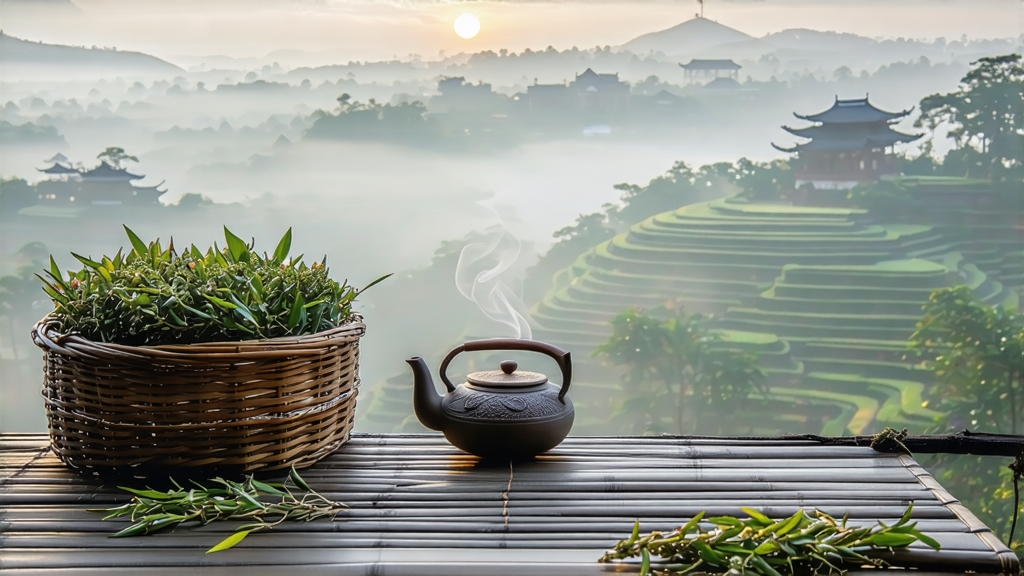
Tucked high on the mist-laced northern ridges of the Sichuan Basin, Meng Ding Huang Ya has been whispered about in Chinese tea texts for more than twelve centuries. Legend claims that the Buddhist monk Wu Li-zhen planted the first seven bushes on Meng Ding Mountain in 53 BCE; by the Tang dynasty (618-907) those bushes, nicknamed “the Immortal Sprouts,” were taxed in tribute, carried by mule train to Chang-an’s imperial courts. When Song emperor Huizong—himself a gifted tea connoisseur—proclaimed yellow the most auspicious of hues, the lightly oxidized, yellow-tinged leaf from Meng Ding was elevated above the better-known green cakes of Jianzhou. For the next six hundred years the tea disappeared and reappeared like mountain fog: Ming scholars praised its “cooling throat,” Qing merchants forgot it in favor of dark puer, and Republican-era planters nearly let the cultivar go extinct. Only in 1959 did a team from the Sichuan Tea Research Institute re-graft ancient mother trees, stabilizing both the shrub and the arcane “sealed yellowing” craft that gives the tea its name.
Meng Ding Huang Ya is not a single clone but a micro-ecotype of the regional Sichuan small-leaf population. Three sub-gardens—Shangqing, Lingyao, and Ganlu—sit between 800 m and 1,400 m, where daily cloud cover filters 30 % of sunlight and nightly temperatures drop 10 °C, forcing the plant to hoard amino acids. Picking begins each year on the first day after Grain Rain (around 20 April) when the bud still hides a tiny fish-leaf that has not yet unfolded. One kilogram of finished tea needs 48,000 such tips, all plucked before ten o’clock so that dew does not add extra cell sap that would later complicate yellowing.
The craft sequence is deceptively simple on paper—kill-green, wrap-yellowing, low-temperature bake—yet each step is timed to the mountain’s humidity, a dialogue between artisan and weather that no written recipe can fully capture. After picking, the buds are spread on woven bamboo trays for six hours of “quiet withering,” losing about 8 % moisture while grassy hexenal volatiles drift off. A 140 °C wok firing lasting only four minutes follows; the tea master’s wrist flips the leaf 180 times per minute, just enough to rupture edge cells while keeping the bud intact. The crucial “men huang” (sealed yellowing) happens next: the warm leaf is piled in linen sacks, 3 kg per bag, and tucked into a pine-wood cabinet at 32 °C and 65 % RH for 60–72 hours. During this micro-fermentation chlorophyll quietly unzips into pheophytin, catechins dimerize, and a mellow chestnut note emerges. Finally the leaf is gently baked at 55 °C for three hours, rested for a day, then baked again at 45 °C; the dual drying deepens the golden liquor color without scorching the downy tips.
Western drinkers often confuse the process with oolong oxidation, but chemically the tea hovers at only 8–12 % oxidation, far below the 30–60 % of Qing-xiang Tie Guan Yin. The hallmark is the non-enzymatic Maillard yellowing that happens in the sealed bags, a slow-motion caramelization impossible in green tea and unnecessary in oolong.
To unlock the mountain in a cup, use a 120 ml gaiwan and 3 g of leaf. Pre-heat until the porcelain feels like sun-warmed jade, then rinse the buds for five seconds; the first infusion should be 85 °C water, poured along the wall to avoid scalding the tip, and decanted after twenty seconds. The liquor glows like light through an old Riesling bottle, releasing aromas of fresh lychee, toasted squash seed, and a fleeting note of Sichuan pepper bloom. Second steep at thirty seconds; the cup gains a custard thickness, the swallow leaves a cool, almost menthol echo at the back palate. By the fifth infusion the flavor thins to alpine creek water, but the honeyed orchid finish lingers for minutes. A glass fairness pitcher helps observe the chromatic shift from antique gold